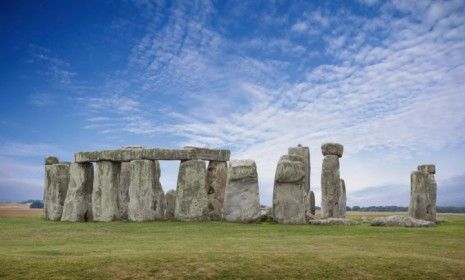The mystery of Stonehenge: Solved?
Forget the druids and aliens. Scientists in Britain say they've figured out the real story behind the puzzling megalith

Theories surrounding Stonehenge's origins seem to go back nearly as far as the stones themselves. Over the course of centuries, philosophers, scientists, and innumerable crackpots have tried to decode the meaning of the monument — composed of several enormous stones arranged in a circle thousands of years ago. Some said Stonehenge was brought to the English county of Wiltshire from Ireland by the wizard Merlin; others posited that it was a druidical temple, an architectural paean to the ancient Egyptians, or a kind of calendar; and still others insisted that aliens must have been involved, since prehistoric humans could not possibly have dragged the giant slabs from quarries more than 130 miles away. However, a research team from Britain now says it has the answer to the riddle of Stonehenge. Here, a guide to the findings:
How was this study conducted?
The research team, made up of scientists from five universities in Britain, conducted "the largest program of archaeological research ever mounted on the iconic monument," according to Science 2.0. Researchers "worked to put Stonehenge in context, studying not just the monument but also the culture that created it," says CBS News.
Subscribe to The Week
Escape your echo chamber. Get the facts behind the news, plus analysis from multiple perspectives.

Sign up for The Week's Free Newsletters
From our morning news briefing to a weekly Good News Newsletter, get the best of The Week delivered directly to your inbox.
From our morning news briefing to a weekly Good News Newsletter, get the best of The Week delivered directly to your inbox.
So why was Stonehenge built?
Researchers say the monument symbolizes the unification of Stone Age Britain, which for centuries had been riven by an East-West divide. The stones are thought to represent different tribal factions, brought together in concentric circles to commemorate the peace. The erection of Stonehenge coincided with the development of an "island-wide culture," in which previously insulated and isolated communities began making similar houses, pottery, and tools.
How did they decide where to put it?
The scientists say the spot had a "pre-ordained significance," because it sits "upon a series of natural landforms that, by chance, form an axis between the directions of the midsummer sunrise and midwinter sunset," says the BBC. The scientists speculate that Stone Age Britons might have viewed the solstice-avenued site as the center of the world.
Sign up for Today's Best Articles in your inbox
A free daily email with the biggest news stories of the day – and the best features from TheWeek.com
How did the stones get there?
The construction of Stonehenge was simply a "massive undertaking, requiring the labor of thousands to move stones from as far away as west Wales," says Professor Mike Parker Pearson, a member of the team. "Just the work itself, requiring everyone literally to pull together, would have been an act of unification."
So — mystery solved?
Perhaps. The research team says Stonehenge is not as uncannily unique as it appears to be. "All the architectural influences for Stonehenge can be found in previous monuments and buildings within Britain," says Pearson. Stonehenge was likely one of the last expressions of Britain's Stone Age culture, which Pearson says was "isolated from Europe and from the new technologies of metal tools and the wheel." However, the mystique of Stonehenge, which attracts thousands of visitors a year and endures as a pop-cultural symbol of ancient mystery, will likely continue.
Sources: BBC, Daily Mail, The Guardian, Science 2.0, Telegraph, TIME, University of Sheffield
-
 Today's political cartoons - March 30, 2025
Today's political cartoons - March 30, 2025Cartoons Sunday's cartoons - strawberry fields forever, secret files, and more
By The Week US Published
-
 5 hilariously sparse cartoons about further DOGE cuts
5 hilariously sparse cartoons about further DOGE cutsCartoons Artists take on free audits, report cards, and more
By The Week US Published
-
 Following the Tea Horse Road in China
Following the Tea Horse Road in ChinaThe Week Recommends This network of roads and trails served as vital trading routes
By The Week UK Published